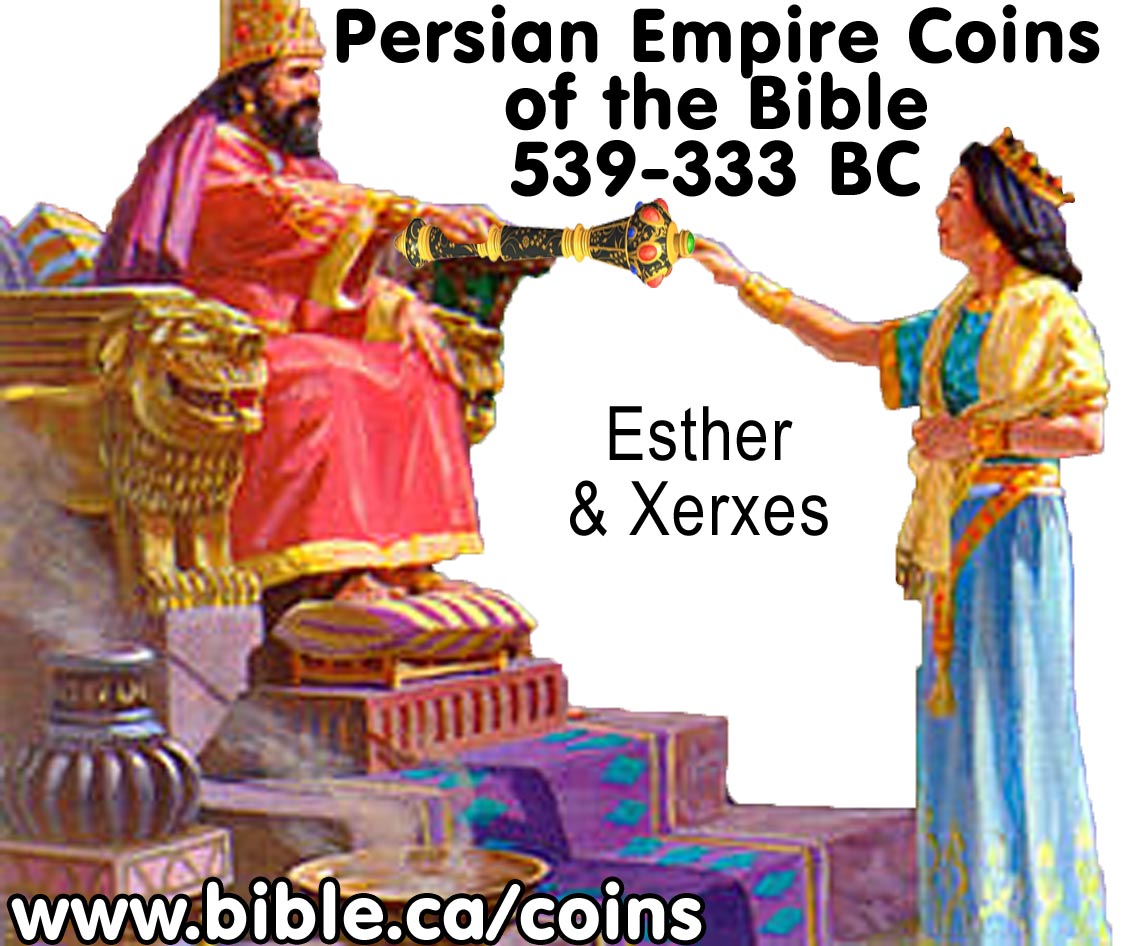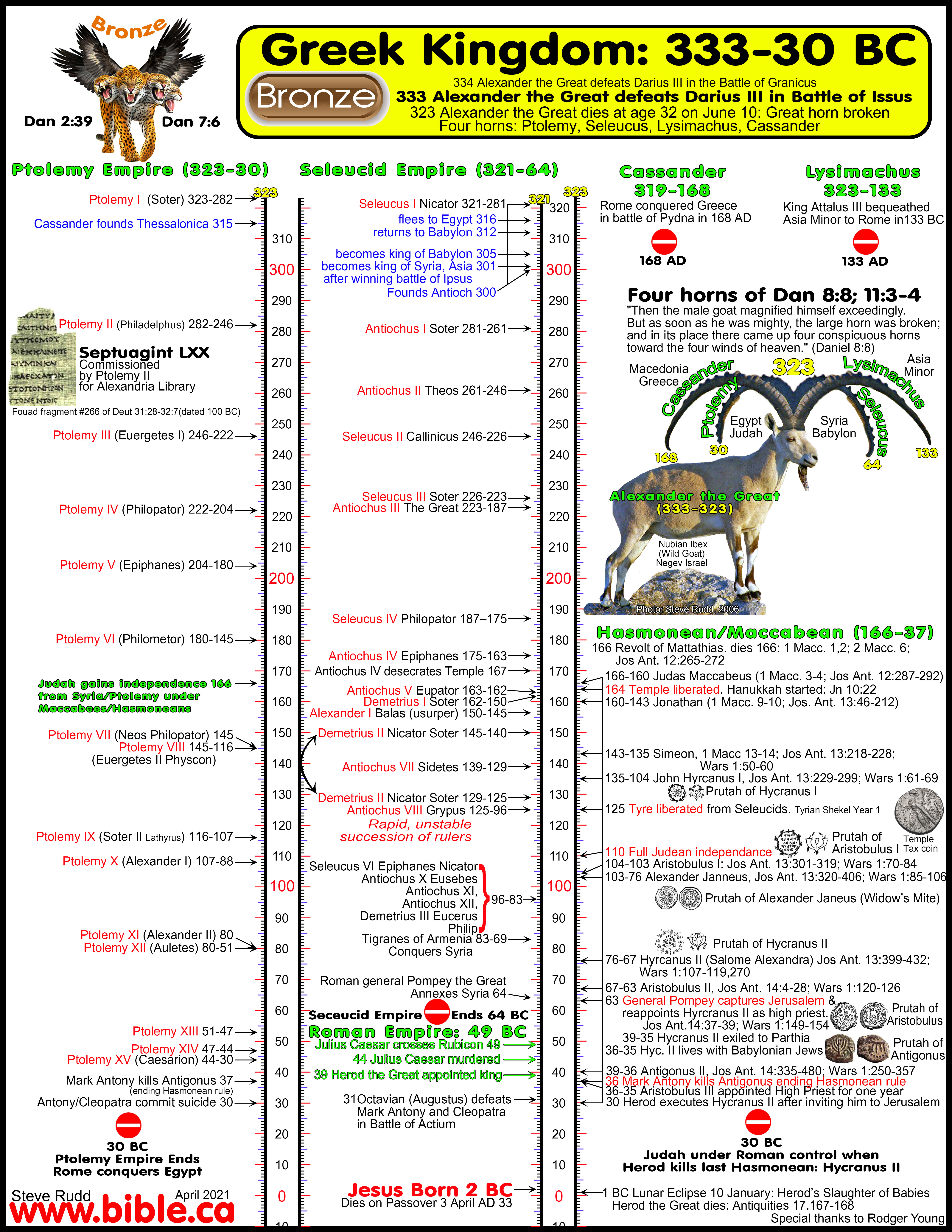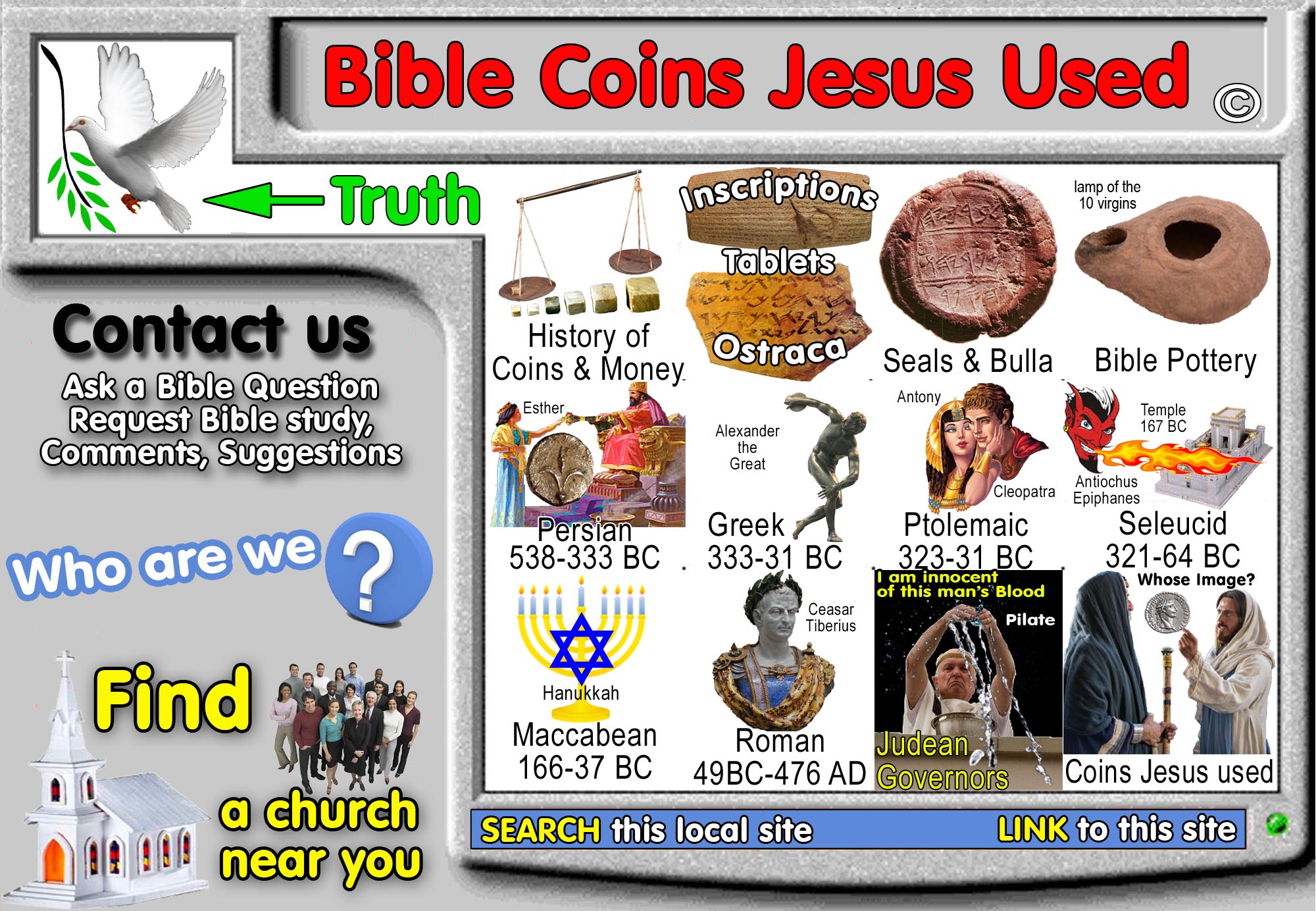Hebrew, Jewish, Bible coins under the Persian Empire (350-302BC)
Coins of the Persian appointed Satraps, Governors of Judah
|
"Hezekiah" (Yehezqiyah) Last Persian Governor of Judea 350-302BC |
"Hezekiah" (Yehezqiyah), Governor of Judea: 350-302BC
Introduction:
- The Bible is silent about many of the Governors of Judea after the Babylonian captivity of 587 BC.
- The books of Nehemiah and Ezra give us the names of three governors:
- Sheshbazzar: The first governor: 533-520 BC (Ezra 1:7–8; 5:14) Sheshbazzar, the prince of Judah."
- Zerubbabel: The second governor: 520-510 BC (Ezra 3:8–10)
- Nehemiah: The Seventh governor: First term: 445-433 BC (20th -32nd year of Artaxerxes I who reigned 464-424BC) Second term: 429-? BC (Nehemiah 2:10; 5:14–15; 8:9)
- We know about Hezekiah, Governor of Judea from coins and Josephus: 350-333BC
II. Two Persian coins of Judean governor Hezekiah
1. HEZEKIAH'S EARLY PERSIAN COIN:
a. 350 - 333 BC is the time when this coin was minted under Persian authority.
b. This coin simply features the word "Hezekiah" in a Hebrew script.
c.
There are numerous well-known seal impressions on handles of jars from
the Persian period, which feature not only the name "YHWD" but also
the personal names of the province's Jewish satraps." "YHWD" (or
"YHD" in unvowelled script) was then undoubtedly the official title
of Judah under Persian rule, but it can even be considered to have applied not
only to the province itself but also to its capital city, Jerusalem. 2 Chron.
25:28 relates the following about the burial of Amaziah king of Judah:
"and they buried him with his fathers in the city of Judah" (769
B.c.E.). The "city of Judah" is certainly Jerusalem, the burial place
of the kings of Judah. A similar appellation is also known from a Babylonian
chronicle from the seventh year of Nebuchadnezzar' s reign: al Ia-a-khu-du =
the city of Judah (599 B.c.E.).26 Moreover, it is evident that the
Persian satrapy of Samaria was call "S'MRYN," as was the city
Samaria. A clear expression of this is to be found in a Samarian document from
Wadi Daliyeh that states: "bgmryn byrta zy bgmryn mdynta" (i.e., in
Samaria the citadel, or city, that is Samaria the province)." From all
that has been said above, it can be concluded that the name "YHD"
appearing on the coin applied both to the city and the province as a single
complex. At that time, the large cities in the Land of Israel, such as Gaza,
Ashdod, Ascalon, Dor, Megiddo, and Samaria, controlled extensive territories
around them and in effect bordered on one another, and thus the city and
province of "YHD" constituted a single political entity."
(Meshorer, p6)

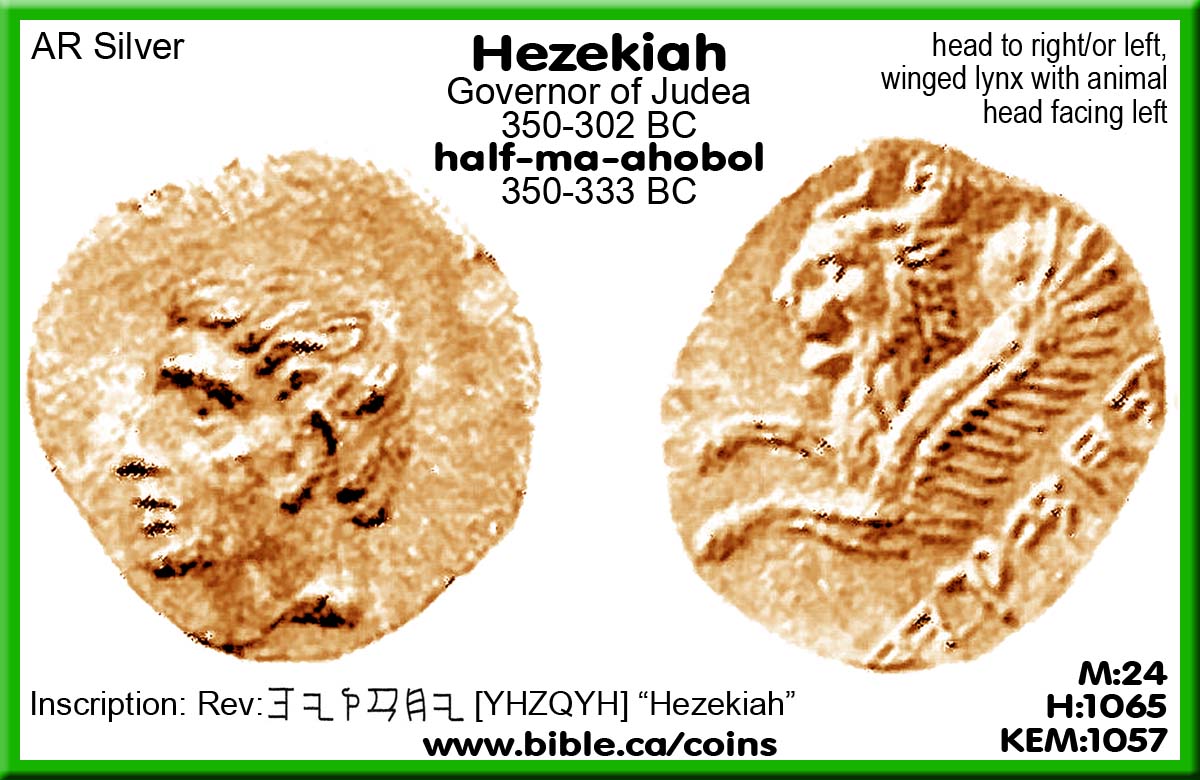
2. HEZEKIAH'S LATE GREEK COIN:
a. 333 - 302 BC is the time when this coin was minted under Greek (Macedonian) authority of Alexander the Great.
b.
This coin features the word "Hezekiah" AND
"governor" in a Hebrew script.
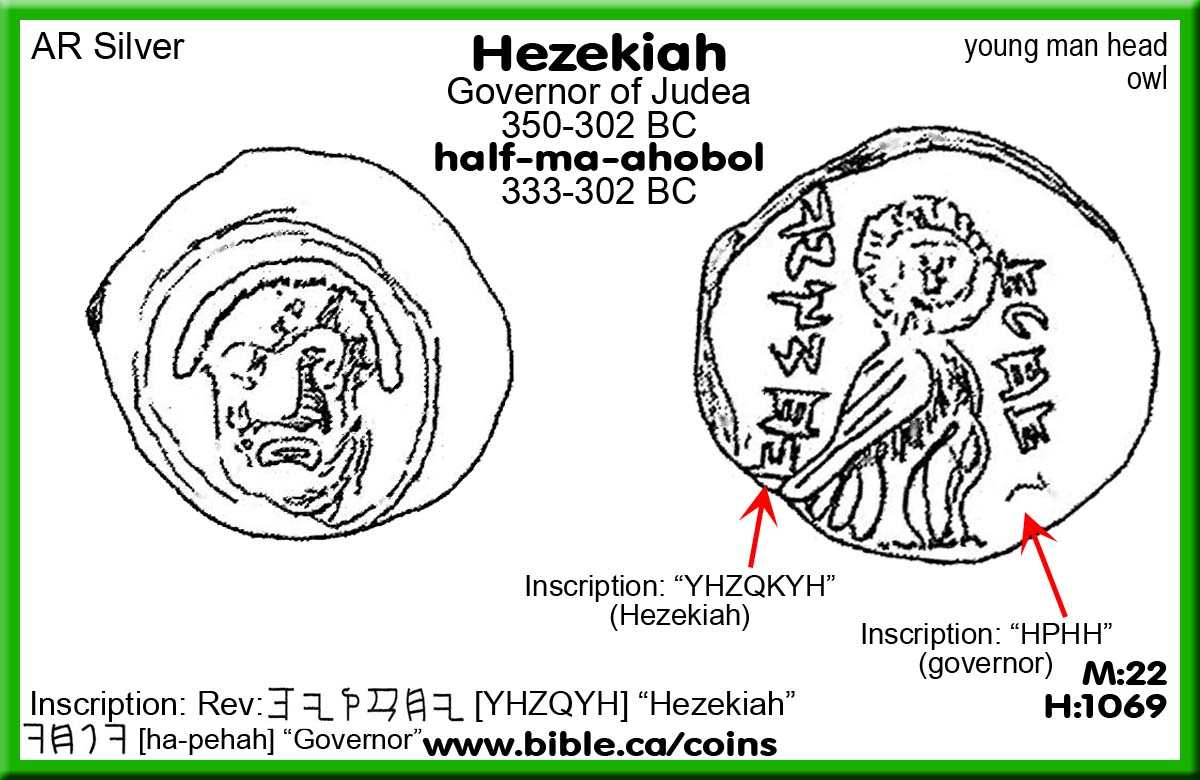
c.
"The term pehah (satrap) as the title of the governor of a
province is well known from the Persian period. Zerubbabel was the first pehah
of Judah in this period (Haggai 2:21), and even the Persian governor of the
entire satrapy on the western side of the Euphrates was called "the
governor on this side of the river" (Neh. 3:7). An Elephantine papyrus
from the end of the fifth century B.C.E. mentions "Bagohi the satrap of
Judah" and his contemporary "Sanballat satrap of Samaria.'53
Among the finds from Wadi Daliyeh, this title is mentioned on a bulla of
Sanballat (the last governor of Samaria during the Persian period) and on
papyri from the days of "Hananiyah the satrap" (354 B.C.E.)."
Seal impressions found on jar handles in Judah feature the names of some of the
satraps, such as Yeho cezer and Ahzai.55 The coins with the
inscription "YHZQYH HPHH" are all of the same type (obverse: head
facing frontward; reverse: an owl). The name "YHZQYH" appears on
another type of coin showing a few changes (Coins 24-26), but without the
title"PHH". However, Coin 24 also has completely different designs:
on the obverse is a youthful male head, and on the reverse the front part of a
winged animal. This leads one to ask a natural question: is this the same
figure or are we dealing with two different people? Anyone looking at
photographs of the coins found attached to one another at Tel Gamma will
immediately discern that three of them are of the type bearing the inscription
"YHZQYH HPHH," while another one is of the second type with a winged
animal.'6 In the latter group are coins featuring the name
"YHZQYH" alone, and this indicates that all the coins are really from
the same time. It is therefore difficult to assume that we are dealing with two
different governors, and we should try to explain why the title "PHH"
is missing on the second type." (Meshorer, p16)
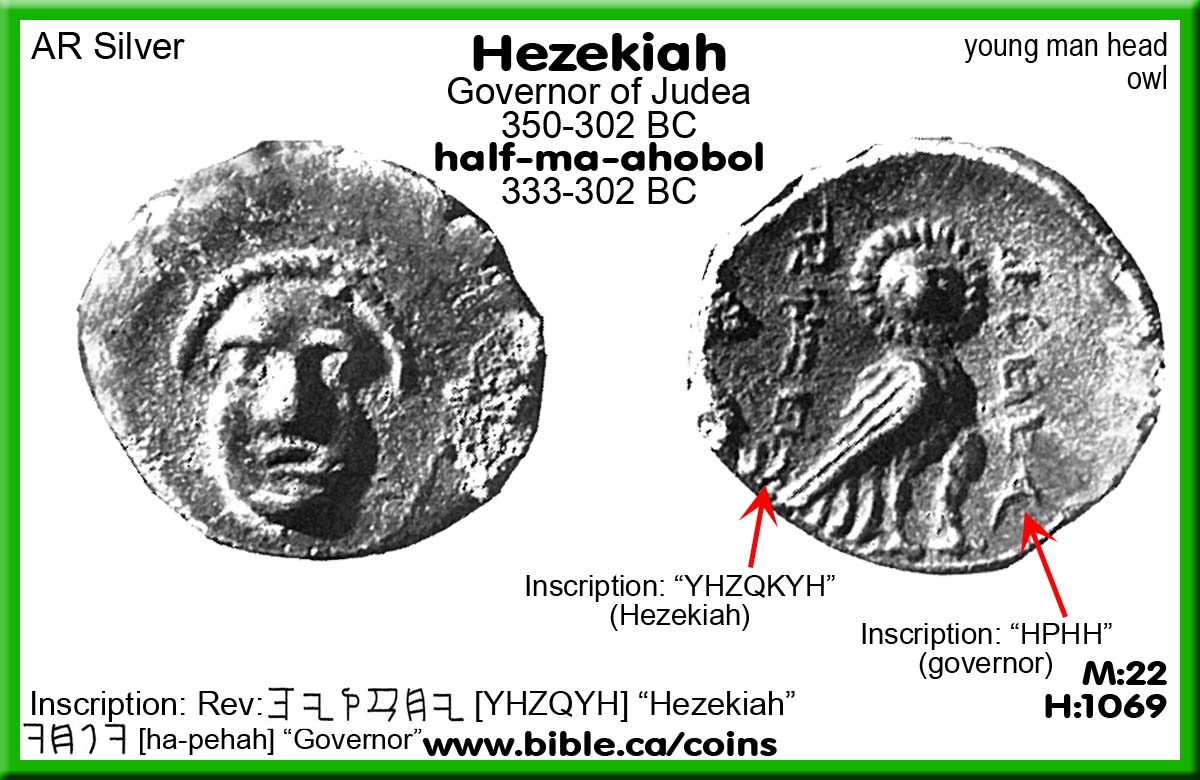
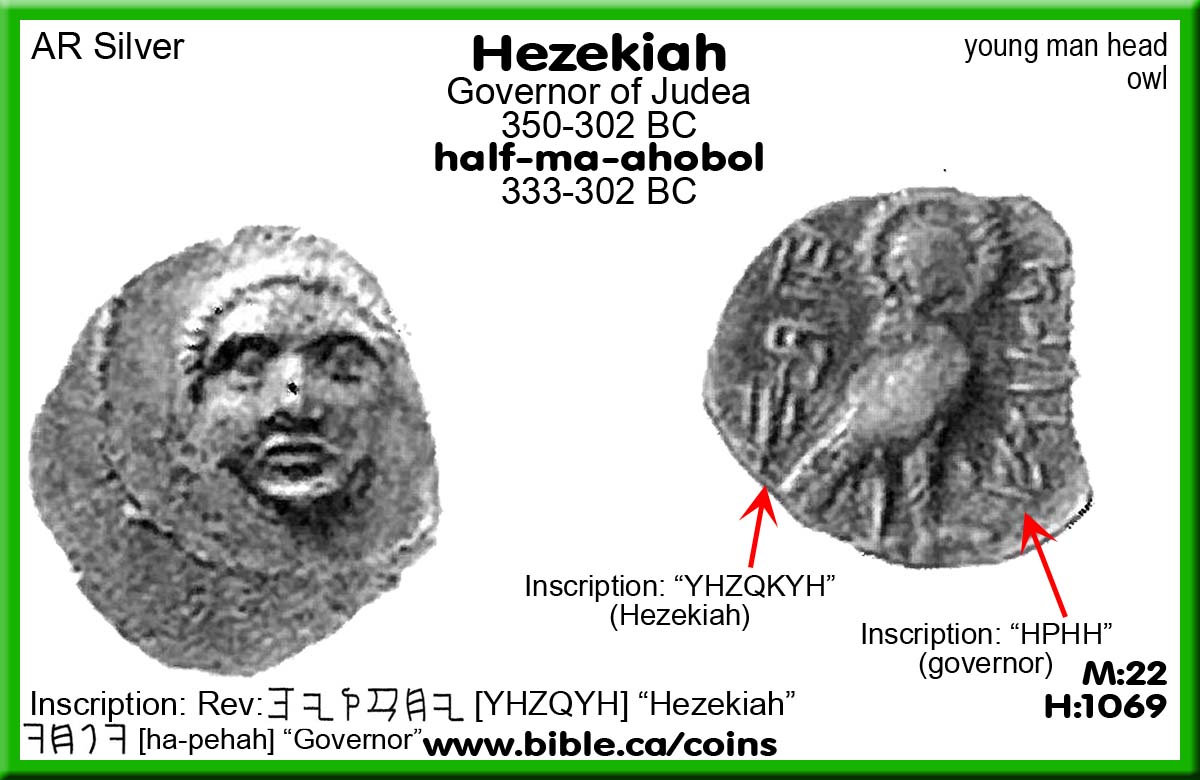
II. Josephus mentions a high priest named Hezekiah by quoting Hecateus twice:
- "It seems likely that the Persians would have continued to appoint an official governor of the province throughout their period of rule, but the last part of the Persian period is largely a blank. However, we have some hints that the high priest may have been appointed as governor, thus combining the two offices. This is based on coins that mention “Hezekiah the governor” and an individual by the same name (Greek: Ezechias), mentioned by Josephus as high priest at the coming of the Greeks (Ag. Apion 1.22, 187–89), suggesting that they may refer to the same man." (The encyclopedia of Judaism, Volume 2, Page 605, Neusner, 2000 AD)
- "Again, Hecateus says to the same purpose, as follows:—“Ptolemy got possession of the places in Syria after the battle at Gaza; and many, when they heard of Ptolemy’s moderation and humanity, went along with him to Egypt, and were willing to assist him in his affairs; (187) one of whom (Hecateus says) was Hezekiah, the high priest of the Jews; a man of about sixty-six years of age, and in great dignity among his own people. He was a very sensible man, and could speak very movingly, and was very skilful in the management of affairs, if any other man ever were so; (188) although, as he says, all the priests of the Jews took tithes of the products of the earth, and managed public affairs, and were in number not above fifteen hundred at the most.” (189) Hecateus mentions this Hezekiah a second time, and says, that “as he was possessed of so great a dignity, and was become familiar with us, so did he take certain of those that were with him, and explained to them all the circumstances of their people: for he had all their habitations and polity down in writing.” (Josephus, Against Apion 1.186-199)
III. Assigning the Hezekiah coins to a firm date line:
- This new dating study confirms that Hezekiah lived across the transition between Persian and Greek kingdoms.
- There was a change in weight system and design of coins.
- We correctly assign the early Hezekiah coins (Hezekiah) to the end of the Persian Empire and the late Hezekiah coins (Governor Hezekiah) to the beginning of the Greek kingdom.
- "The dating of the Yehizkiyah coin types to the late Persian period may be corroborated by the metrological study of these issues.35 Coin types TJC 26, 24, 25 seem to have been issued under the Persic standard and correspond to a half gerah, namely an issue of c. 0.24 g. These types are definitely heavier than the Yehizkiyah hapehah coins, which were issued under the Attic standard and have an average weight of 0.18 g a quarter obol). It is clear that the change of weight standard occurred during the period when Yehizkiyah was signing the coinage as its issuing authority. Based on the stylistic artistic observations noted above and the metrological study, it seems likely that TJC 26 should be dated to the late Persian period. A similar date can be considered for TJC 24 and 25, despite the recent suggestion of Gitler and Lorber that TJC 25 could belong to the late Macedonian period, shortly before the final Ptolemaic occupation of Palestine. The fact that in the Tel Gamma 1970 hoard a Yehizkiyah TJC 24 coin was found together with three Yehizkiyah hapehah specimens of type TJC 22 shows that the former issue was still in use after the change of weight standard." (A new chronology for the Yehizkiyah coins of Judah Haim Gitler, Catharine Lorber, 2008 AD)
- "While it seems clear that coins depicting the Great King must belong to the Persian period and coins of Attic weight can be dated after the Macedonian conquest, we do not know precisely when the mint of Judah abandoned the Persic weight standard in favor of the Attic standard. It is enormously unlikely that this change was imposed by Alexander himself. Driven by a lust for conquest, he had little interest in administering his new territories and exercised almost no supervision over the satraps he appointed to govern in his place. Aramaic ostraca from Idumaea demonstrate that the system of tax collecting did not change after Alexander’s arrival, and it probably remained unchanged in Judah as well. As for monetary policy, in western Asia Minor Alexander presented himself as liberator of the Greek cities and may not have opened imperial mints until near the end of his reign. Tarsus, under Alexander’s satrap Balacrus, continued to strike local coinages on the Persic standard in parallel with Alexander’s new imperial coinage on the Attic standard. It is true that Alexandrine mints opened fairly promptly at Sidon, Tyre or Ake, and perhaps Damascus. But their early output was limited, suggesting that Alexander’s policy was to supplement local coinages, as in Cilicia, not to supplant them.58In Babylon, where coinage had not existed previously, Alexander’s satrap Mazaeus issued a ’native’ coinage in his own name alongside Alexander’s imperial coinage. All of these examples suggest that Alexander would have allowed his governor in Judah full authority to make decisions concerning the local coinage. We can thus conclude that if Yehizkiyah changed the weight standard for political reasons, he must have done so after Alexander’s death, in response to one of the Successors. However the change of weight standard could have been motivated by other concerns. At some point the Attic weight Alexanders may have come to dominate local currency markets, so that it seemed preferable to assure easy exchange by conforming to their weight standard. It is also worth noting that the change of standard resulted in the production of generally lighter monetary units the quarter obol of c. 0.18 g instead of the half gerah of c. 0.24 g), even though the Attic standard is heavier than the Persic standard." (A new chronology for the Yehizkiyah coins of Judah Haim Gitler, Catharine Lorber, 2008 AD)
|
Suggested Chronological Order of the Yehizkiyah Series and other related issues of Judah |
||
|
TJC 26 |
Head of horned lynx/forepart of winged feline with head of Persian king, Yehizkiyah |
Persian period |
|
TJC 24, 25 |
Male head/forepart of horned and Late Persian or winged lynx, Yehizkiyah |
Macedonian period |
|
TJC 25a |
Facing head/forepart of horned and winged lynx |
Macedonian period |
|
TJC 22–23 |
Facing head/owl, Yehizkiyah hapehah |
Macedonian period |
|
TJC 20, 21 |
Facing head/owl, Yohanan hakohen and Yehud Yehudah |
Macedonian period |
|
TJC 14 |
Lily/owl |
Macedonian period |
|
TJC 28 |
Lily/eagle with head reverted, Yehudah |
Macedonian period |
|
TJC 27 |
Roaring lion/eagle with head reverted, Yehudah |
Macedonian period |
|
Gitler-Lorber 2006 |
Facing head/eagle with spread wings, Yhd |
Earliest Ptolemaic issue, c. 302/1 |
|
A new chronology for the Yehizkiyah coins of Judah Haim Gitler, Catharine Lorber, 2008 AD |
||
Conclusion:
- This is one of those times when archeological information from outside the Bible helps us fill in gaps of information.
- The Bible is all-sufficient for everything we need for life and godliness.
- "Grace and peace be multiplied to you in the knowledge of God and of Jesus our Lord; seeing that His divine power has granted to us everything pertaining to life and godliness, through the true knowledge of Him who called us by His own glory and excellence. For by these He has granted to us His precious and magnificent promises, so that by them you may become partakers of the divine nature, having escaped the corruption that is in the world by lust." (2 Peter 1:2-4)
- While we do not need this information, it does help us understand the larger picture of the ancient world of the bible.
- Hezekiah was likely the last governor of Judea for the Persian Era and the first governor under Alexander the Great.
- Hezekiah lived through the conquest of Alexander the great in 333 BC, which ushered in the Greek Empire.
- For a short 10 years Alexander the Great ruled the world in a stunning and unparalleled take-over but then he died.
- The prophecy of Daniel's four kingdoms continues to be fulfilled: Dan 2:39
- Alexander's kingdom was divided up into four smaller kingdoms just like Daniel had predicted: Dan 7:6
- Hezekiah the governor may have lived to see it all!
By Steve Rudd: Contact the author for comments, input or corrections.
